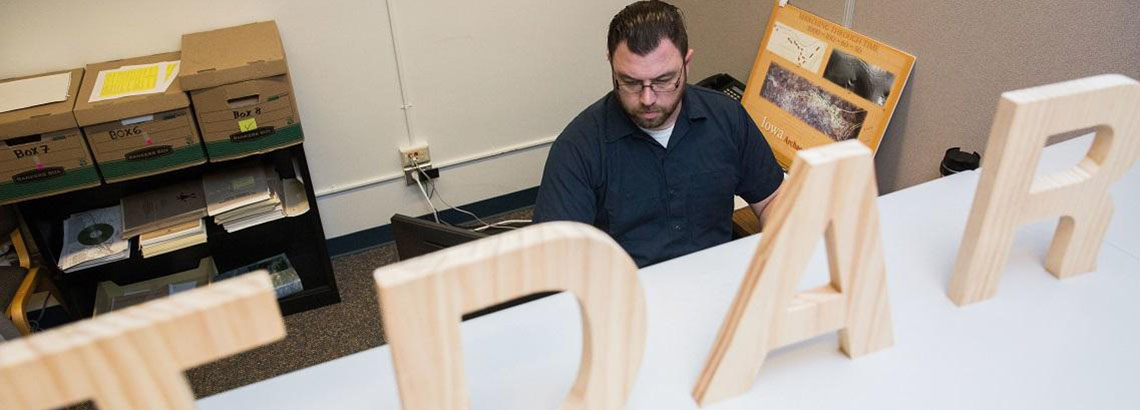
From Military Duty to Metadata: The Center for Digital Antiquity Partners with the USACE Veterans Curation Program
The US Army Corps of Engineers created the Veterans Curation Program with two goals in mind: 1) to provide veterans technological training and temporary employment to support their transition into civilian life, and 2) to process the numerous at-risk archaeological collections owned by the USACE. At ASU, the Center for Digital Antiquity has partnered with the USACE and Pat Tillman Veterans Center to employ and train student veterans as digital curators. At Digital Antiquity, student veterans are taught a range of technological skills related to the digital preservation and curation of archaeological records. Using Digital Antiquity’s The Digital Archaeological Record, the nation’s largest digital repository of global archaeological data, student veterans are ensuring these irreplaceable resources are preserved and accessible to the public for scientific research and education into perpetuity. In this way, the VCP provides an innovative path for veterans to gain versatile technological skills to better compete in the mainstream job market, while simultaneously delivering a valuable public service to current and future archaeological researchers around the world.
Project Details
The US Army Corps of Engineers is responsible for the stewardship of numerous archaeological collections excavated during the construction of the county’s many water control systems and reservoirs. As such, USACE offices around the nation house decades’ worth of irreplaceable archaeological data in various formats, including paper documents; physical photographs and slides; and digital files saved on obsolete disks, drives, and other platforms which are difficult to access and are vulnerable to catastrophic loss. In 1991, recognizing the urgent need for this irreplaceable information to be rehabilitated for long-term preservation and ultimately released to the public for research and educational purposes, federal regulations Title 36 CFR Part 79 (Curation of Federally Owned and Administered Archeological Collections) and ER 1130-2-433 (Collections Management and Curation of Archaeological and Historical Data) were implemented. Between 1993-2011, the Mandatory Center for Expertise for the Curation and Management of Archaeological Collections in St. Louis investigated the backlogs of the at-risk archaeological and cultural resources stored within federal agency offices. Their findings were published in a series of reports describing the curation measures needed to achieve the goals of these federal regulations.
Meanwhile, many veterans returning from overseas operations in Iraq and Afghanistan found that they lacked key technological training required to effectively compete in the mainstream job market. Seeing a mutually beneficial way to support veterans through the transition from military service into the public sector workforce, while simultaneously rehabilitating the backlog of vulnerable archaeological records, the USACE, with help from the cultural resource management company New South Associates, developed the Veterans Curation Program.
Founded in 2009, the VCP is a five-month employment program which offers veterans the opportunity to gain transferable office and data management skills by working alongside archaeological professionals on the USACE’s archaeological collections rehabilitation project. The veterans build upon skills acquired during their military service, such as leadership, teamwork and attention to detail, through hands-on training using industry-specific technology to accomplish a variety of important tasks in the processing of archaeological records and materials. Rehabilitation and processing can take many forms, from cleaning and storing physical artifacts to digitizing and uploading documents, photos and other data into a secure online data repository. The ASU Center for Digital Antiquity specializes in the latter, with tDAR serving as the largest secure and sustainable digital repository of global archaeological data in the nation. tDAR’s services were an ideal match for USACE’ s needs, providing migration of data from obsolete formats to future-adaptable digital files and storage in tDAR’s ever-expanding online repository, ensuring the preservation of and access to these records into perpetuity. Digital Antiquity partnered with the innovative VCP program in 2016, working with USACE and the Pat Tillman Veterans Center to employ and train student veterans in the digital curation of archaeological records. Veterans working for Digital Antiquity are tasked with combing through digitized archaeological records to organize data, identify and redact sensitive information, create metadata to ensure the records’ discoverability in online search engines, and, finally, to upload files into tDAR for public use and reuse.
Since its inception, the VCP has employed and trained more than 420 veterans who have rehabilitated over 230 archaeological collections from 11 Corps Districts. The Center for Digital Antiquity is proud to have employed several of these talented, hardworking veterans over the past four years. Together, our veteran curators have made impressive contributions into tDAR, curating and uploading almost 7,000 archaeological and cultural resources, including 1,233 documents, 423 data sets, and 2,323 images. Of the veterans employed in the VCP nationwide, 73% have obtained permanent employment while another 16% have pursued higher education, demonstrating the Veterans Curation Program’s success in supporting veterans’ transitions into civilian life.
Partners: U.S. Army Corps of Engineers | Pat Tillman Veterans Center | New South Associates | Mandatory Center for Expertise for the Curation and Management of Archaeological Collections
Research Team
- Rachel Fernandez, Arizona State University
- Francis Pierce-McManamon, Arizona State University
- Mary Whelan, Arizona State University
Funding
tDAR Veterans Curation Program Grant